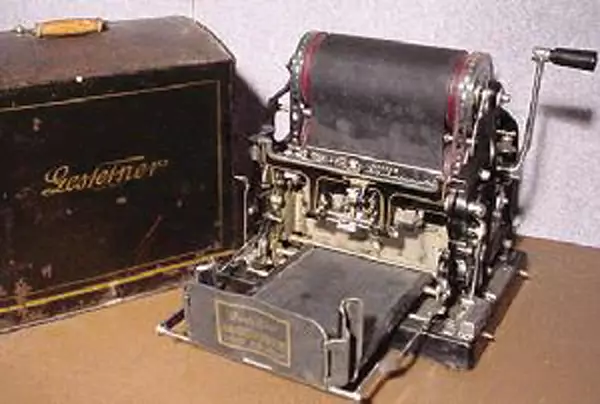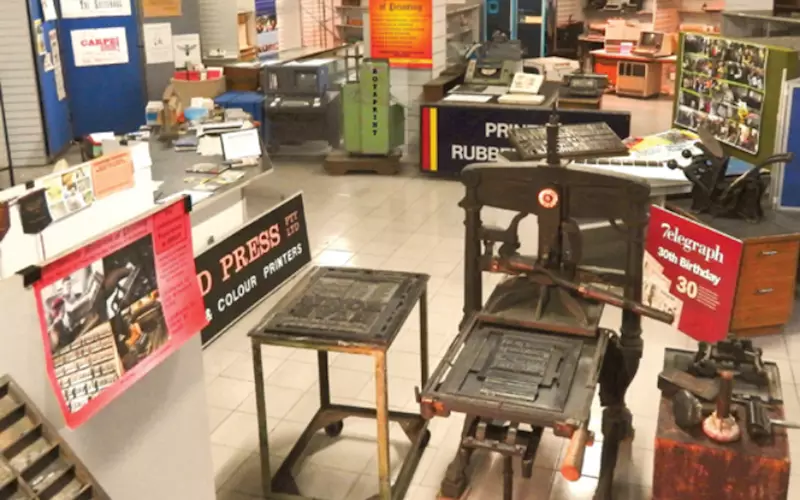Print History: Rough Weather - Melbourne Museum of Printing
Printing museums across the world have become success stories but it is not plain sailing always. The story of the Melbourne Museum of Printing illustrates some of the pitfalls which printing museums can encounter
27 Dec 2021 | By Murali Ranganathan
In 1977, Michael Isaachsen, then in his thirties, established a type foundry for casting types in Melbourne. These types were used to compose text by hand; it was a technology which was nearly five hundred years old in the western world. Though it was still in use across the world, hand composing had long been superseded by other technologies such as hot-metal composing and phototypesetting. It was a rather strange project as this was a period when the print industry was going through a technology upheaval. Printing presses across Australia were transiting from the century-old hot metal composing technology to phototypesetting and digital technologies. Types used for composing text by hand were worth less than the metal they were made of. However, Isaachsen felt that a foundry might still pay its own way. All through the 1980s, classic machines like the Linotype and Monotype were being discarded and sold for scrap.
Isaachsen was perhaps the only buyer in a market which had hit rock bottom. He was buying printing equipment faster than he could catalogue them. They would be stored in warehouses scattered all over the outskirts of Melbourne. Isaachsen was not just another print practitioner with a passion for printing history.
Even before it was officially designated as a museum, the type foundry began to attract visitors who were interested in the history of print. In 1992, the type foundry was recast as a printing museum and christened the Melbourne Museum of Printing. Over the years, the reputation of the Melbourne Museum of Printing continued to grow and it was soon recognized as the unofficial national printing museum of Australia

Adana table-top printing press
Print Precocious
Michael Isaachsen’s obsession with print began at a rather early age. In an interview with ABC Radio in 2008, Isaachsen reminiscences about growing up in Adelaide.
When I was young, I loved printing. I started being interested in printing when I was nine years old. I used to wag it from school and go into the city (this was in Adelaide) and look around at all the interesting places and factories. It’s a wonder they didn’t kick me in the tail and send me back to school, but no-one did. And I explored lots of industries, but there was nothing more interesting than the printing shops and their Linotype machines. I wasn’t a great fan of hand typesetting at that stage. I knew about it, but it was the Linotype machine that got me in. But I was never allowed to touch one. I would have to do the trade and be a qualified tradesman before I could ever put my hands on it. And I always felt a bit frustrated about that.
This frustration perhaps led to his father buying him a small desktop printing press at the age of eleven. All through his teenage years, the press used to function from his bedroom and as he recalled later, “They used the same kind of hand-set or Linotype typesetting as commercial presses and could print cards and tickets, letterheads and small flyers with professional results.” This obsession with printing was not a mere childish obsession. It stayed with Isaachsen all through his adult years when he worked with Australia Post.
Museum Mania
The Melbourne Museum of Printing was conceived as a not-for-profit museum which would be self-sustaining. It would generate revenues from its type foundry, from the print jobs the press would execute, from the professional courses it would conduct, and from heritage print practitioners who would use its printing machines. The museum would not have any employees or management. It would be staffed only by volunteers, men and women who had been part of the printing industry in an earlier era. It would not have a board of trustees or a committee of management. The revenues would be used for paying rent for the museum premises, for keeping the machines in operating condition, and for any other related expenses.
The displayed collections are arranged to recreate a working environment of a middle-of-the-century printing press. Isaachsen estimates that the collection includes over 200 machines including a bank of Linotypes. The oldest printing press in the collection is an Albion Press, made by Wilsons of London in 1849. It also has a large collection of types and an operating type foundry.

Gestetner Duplicator
Its artefact collection includes “tens of thousands of engraved blocks, stereotypes, electrotypes, typeformes, printers ornaments, hand tools, artwork, negatives, plates, proofs, printed samples, job bags, quotations, invoices, business records, books about printing,” and much more. What is displayed is just the tip of the proverbial iceberg. Though the museum moved to successively larger premises, it could never afford an area big enough to showcase the entire collection.
Isaachsen was the soul of the organization who kept it going. Though attempts were made, the museum did not manage to raise any sponsorship or grants. It also could not develop strong associations with academic programmes in universities or with the printing industry. Neither could it generate interest among governmental bodies.
Present Tense
In 2018, Michael Isaachsen met journalist Joe Hinchliffe at one of the warehouses where he stored printing equipment. This resulted in a vivid pen portrait of the artist at work in the Australian newspaper The Age (March 31, 2018):
Inside a warehouse in western Melbourne, a retired craftsman turns on a relic of a machine and begins to practise a dying art. As the engine fires up, a spiderweb of pulleys and cables whir into life. The man levers a metal magazine into the frame of the machine and locks it in place. Like the man, the machine is heavy-set—it stands about two metres tall and weighs a tonne-and-a-half. As he cranks handles and adjusts dials, the man looks for all the world like the pilot of some steam-powered aircraft.
He sits on a stool at a keyboard made improbably small by both the machine to which it is attached and the stubby worker’s fingers that tap its keys, quick and delicate. The machine is set aclatter. Like a tractor engine with its hood up, the process is visible to the naked eye—through his glasses, the man can see its melting pot heat to about 300 degrees and the lead it holds transformed to liquid. The machine arranges letter moulds corresponding to the keys that the man taps into a line. Into this the molten lead is pumped—within a fraction of a second it solidifies and the letters that the operator typed form a metal bar called a slug. A series of knives slice the slug into shape and it falls into a tray.
Letter moulds—or matrices—are pulled up to the top of the machine by a series of long arms and elevators. Then they fall, down through channel and chamber, back into their allocated magazines with the strangely soothing sound of metallic raindrops. The man continues to type as his typed words are transmuted into lead.
Though Isaachsen was hoping for a similar magic of transmutation to occur in his museum, it did not come to pass. Within a few years of its operation, it become obvious that the museum could not function merely as a self-sustaining organization but needed generous grants and sponsorship to ensure its continued existence. Speaking in 2010, Isaachsen was clear that “the key to the museum’s fate lies in the public taking an active interest in the working museum.”

Monotype composing machine with keyboard
But lamented that “I’ve been speaking to printers, suppliers, government and philanthropists but I really need someone other than myself to generate the interest. Up until now, I haven’t found anyone who has been able to put the case to these industry people and government.” Isaachsen estimates that he and his family would have invested AUS$ 4 million into the museum over the years. Additionally, the unpaid rent had accumulated to over half a million dollars.
On a fine sunny Melbourne morning in February 2018, the landlord of the premises in which the museum was located, who had been supportive for years, served notice for eviction and eventually auctioned the heritage print treasures to compensate for his losses. Though many of the machines were eventually rescued by friendly purchasers, the museum is no longer functional. It would seem to be the end of the road for the Melbourne Museum of Printing. However,
Michael Isaachsen is made of sterner stuff. He has prepared a regeneration plan for the museum and continues to hope that funds can be raised to revive the museum.
Future Forward
The Melbourne Museum of Printing is not the only printing museum to have faced financial or other crisis situations. Unless there is a print ecosystem which actively supports a printing museum, it would be impossible for most of them to exist as self-financing institutions. The print ecosystem consists of print industry majors, publishing houses, print technologists and boutique print practitioners, supported by academia and local and national governments. The museum would need to be adequately staffed by professionals experienced in print history, print technology and museology. Systems have to be put in place at the very inception of the museum to ensure long-term funding. The museum would have to offer accredited training and certification programmes in association with academic institutions. It has to develop networks within the international printing museum circuit as well as with other local museums.

Michael Isaachsen, pic by David Smith via Maribyrnong Leader (March 9, 2010)
In India, the environment for museums is particularly challenging on every count. Raising funds from industry and grant foundations is not an easy task. Real estate costs are disproportionately higher than in most other countries. The availability of trained and committed museum personnel is constrained. The culture of visiting museums and paying for the unique experience is not widespread among Indian masses. Under these circumstances, the challenges for a new printing museum are multiplied manifold. Not only is the subject matter without precedent, most stakeholders would have to educated about print history. Notwithstanding all these challenges, a well-planned project mindful of the pitfalls can surely succeed. Given the rich history and long tradition of print in India, the time has come for printing museums in India.
All images copyright Melbourne Museum of Printing (www.mmop.org.au)











 See All
See All